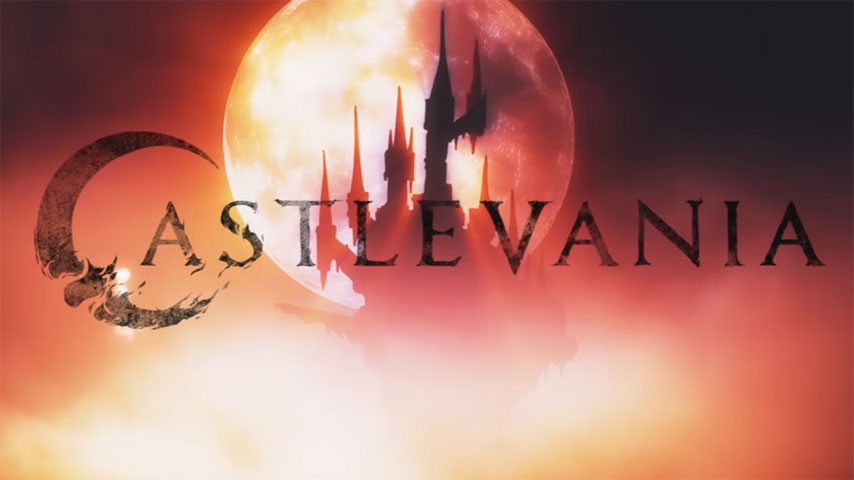 Well, spatter me in raw, red and wet surprise. Who in their right minds would have thought this would work? Adaptations of video game franchises to screen -or any other format- have a nasty tendency to disappoint at best; usually either too far from the source material to warrant sharing its name or so slavish they murder themselves in the effort to recreate it verbatim. The announcement of Netflix's adaptation of Konami's classic Castlevania franchise into an animated TV series certainly intrigued initially, if only for its strangeness and near absurdity: whilst the franchise continues to this day in various different forms, most recognise it as a 2D, side-scrolling platformer with a gothic horror bent, from a time when stories in video games could be consigned to half a page in instruction booklets. Whilst Castlevania certainly has a number of rich seams of mythology to draw on, cohering them into something recognisable as the video game and not just another weary vampire anime was always going to be a daunting task. 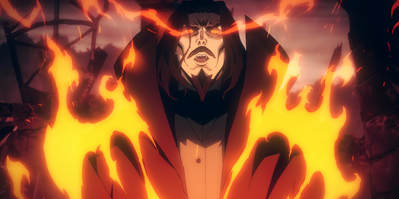 More than anything, curiosity is what made me sit down to watch the first instalment. They got it right. Very, very right indeed; not in the sense that the series serves as a recreation of the video games, rather that the creators have somehow struck that fine balance between paying enough homage to them as to be recognisably part of their universe, whilst simultaneously elaborating upon that universe sufficiently to make the show its own entity. Opening on the eponymous structure itself, eminently recognisable to anyone who's played any of the games as the architecturally impossible, non-euclidian castle that is Dracula's lair; an insanely elaborate edifice far, far removed from classic depictions that dominate written fiction and cinema, the show immediately impresses with its design and atmosphere. A stunningly rendered, foreboding structure, insane in its gothicism, looking as though parts of it float without anchor to the rest, others resembling the interiors of warped clocks or shattered sea shells, it's an arresting image, and one that pervades the entire show. Dracula himself is also a surprise; threatening, malevolent, but also patient, charming and sympathetic, at least initially; a take on the character that neither the games nor the fiction from which they derive provide, closer to the love-lorn monster of Francis Ford Copolla's 1992 adaptation than the unambiguous hellspawn of the original novel. Quiet, poised, charming; a monster, certainly but one not without thought or conscience. This incarnation of the classic myth establishes that, whilst there are certain synchronicities with those that have gone before, both the iconic vampire and the world in which he occurs are removed from what most would recognise: this is not, for example, the familiar Transylvania of the original novel and the majority of its film adaptations; rather, this Dracula occurs in the semi-fictional Wallachia; a pseudo-European nation, seemingly composed of various smaller territories all of which are named after places that fans of both classic Dracula lore and the video game series will recognise. Likewise, it doesn't appear to be set in any particular time period; Dracula's castle itself, as in the video games, simultaneously gothic and science fiction in composition, its interior boasting as much in the way of technology as it does gargoyles, sepulchres, tapestries etc. Whilst the series doesn't delve too deep into Dracula's background, there's certainly an abiding suggestion that he is a timeless, immortal entity whose scope and intelligence transcend humanity's so as to render him alien to them. Dracula actively removes himself from previous incarnations of the character by describing the nature of his castle; apparently an “engine” that can move through time and space at his will. 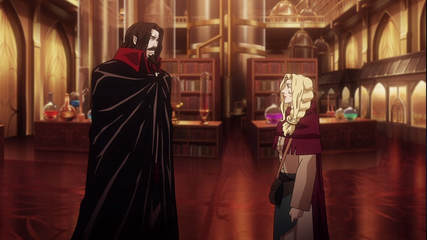 The first few scenes also establish how strongly characterised even the supporting or incidental cast are; whereas in most incarnations of the myth, the woman who will eventually become Lisa Tepes, Dracula's wife, would have been a victim to establish Dracula's heinousness and monstrosity, here, she's a head-strong, intelligent and wilful woman who not only survives her initial meeting with the vampiric count but charms him with her humanity; a woman of reason and science who seeks to break the stranglehold of superstition and religiously proscribed ignorance that blights Wallachia. The series, wasting no time, given its limited run, fast forwards some years from this point, to the ritualistic burning of Lisa at the church's behest for the “crime” of witchcraft. Economy of storytelling and establishment of character is all important here, as the show is extremely short, given the density of back mythology and range of characters it attempts to convey, and it does so with remarkable impact, Lisa herself barely on screen for more than ten minutes, from the moment of her introduction to the point of her death, but becoming the fulcrum upon which the entire show turns: her death serves to establish the hideous corruption of the church that dominates Wallachia, the lust for power that pervades its upper echelons, but also the factor that drives Dracula -who has been “wandering as a man” at his wife's behest- so deep into grief and misanthropy that he unleashes all Hell upon humanity. 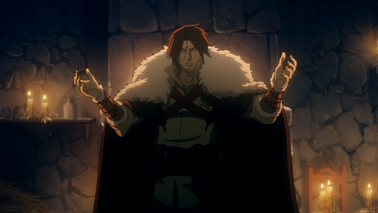 Fans of the game might find this curious for an opening episode, as, although we do meet franchise favourite characters such as Alucard, Dracula and Lisa's son, there's not a sigh or suggestion of the Belmonts, who tradtionally have been the player characters in most Castlevania games, until episode 2. That said, the show utilises what chance it has to establish the rules and dynamics of its universe beautifully, very little stated outright; much left to implication and visual cues, raw atmosphere and emotion the core of its appeal, the dynamics between the characters natural, immediate and complex, the powers at work within its world established without redundancy. As for protagonist Trevor Belmont, his characterisation may come as something of a surprise to fans of the franchise; far from the dauntless hero of the video games, Trevor is outcast and disgraced, the Belmonts themselves a family whose excommunication by the church has driven them to dereliction. We first find Trevor drunk and near pennilless in a village bar, begging for drinks, stinking to high Heaven, getting into bar fights with the locals, where he demonstrates something of the capacities that made his family celebrated monster hunters, but not enough to keep him from disgrace. Like many of the characters in this series, he's ambiguous at best; a sardonic, vagrant man who seems to only care about where the next drink is coming from, drawn into the conflicts between Dracula's hordes and the church by circumstance and accident, though glimmers of the man he might be do start to show through the accrual of disgrace. Funny, eloquent and bitter, Trevor is a surprising take on a character who could have been easily two dimensional and dully heroic, forced into defending people he doesn't particularly like, and who are so sheepish in their desperation and blind faith they almost end up murdering him at the church's behest at various intervals. 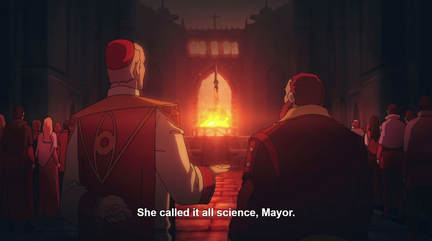 Regarding the church, some veiwers might be alienated by the show's portrayal of religion: there is no subtlety or nuance, here: the church -which, whilst not specifically named as the Catholic church, is this world's equivalent thereof in almost every respect- is an unambiguous force for harm in this world; not only is it the self-serving misogyny and cruelty of the church that brings Dracula's wrath upon the land, but it is the church that seeks to capitalise on the situation to secure its powerbase, turning the people against whatever scapegoats prove convenient so as to further secure their authority, which, inevitably, brings them into conflict with Trevor Belmont and his allies. Interestingly, the vein of misanthropy that runs throughout also lends the show a certain moral ambiguity; whilst Trevor and those who eventually fall in line with him are portrayed as the heroes of the piece, the weakness, sheep-like naivety and scapegoating tribalism of most of the people they encounter, not to mention the manifold atrocities committed by the church, has the effect of making the viewer -at least in my case- side almost entirely with Dracula. As Dracula himself points out, the species demonstrates again and again that it is worthy of no better; he is merely wiping the slate clean, hastening the demise and damnation it will inevitably bring upon itself. The show is also surprisingly true to its horror roots, despite being based on a franchise that made its name when video gaming in the West was aimed squarely at younger demographics; full to brimming with blood, gore and dismembered body parts; images of demons tearing apart men, women and children, devouring babes...the Hell that Dracula unleashes is quite literal; elemental evil made manifest in the world, and therefore all of the very worst he can visit upon humanity is rendered here, without conscience or ambiguity. Do not think that, like many shows of its ilk, children or women or the elderly are somehow involate; there are no innocents, as Dracula himself proclaims, in the depths of his grief, and so, the show provides none: only deeper and deeper atrocities, escalating situations of pain and grief and despair.
It's an interesting note to go forward on, these four episodes largely serving as an extended pilot episode to establish the back mythology, principle players and dynamics of the story. In that, it leaves the viewer somwhat unsatisfied, as it feels as though it ends just as the action picks up pace, but this is entirely intentional, ensuring that a significant number will be clamouring for when the show hauls itself from the circles of Hell once more and wreaks havoc on the living. Short, violent, surprisingly sophisticated, grimly charming; arguably a candidate for the most successful video-game-to-screen adaptation ever attempted.
0 Comments
Leave a Reply. |
AuthorGeorge Lea is an entity that seems to simultaneously exist and not exist at various points and states in time and reality, mostly where there are vast quantities of cake to be had. He has a lot of books. And a cat named Rufus. What she makes of all this is anyone's guess. Archives
May 2020
Categories |
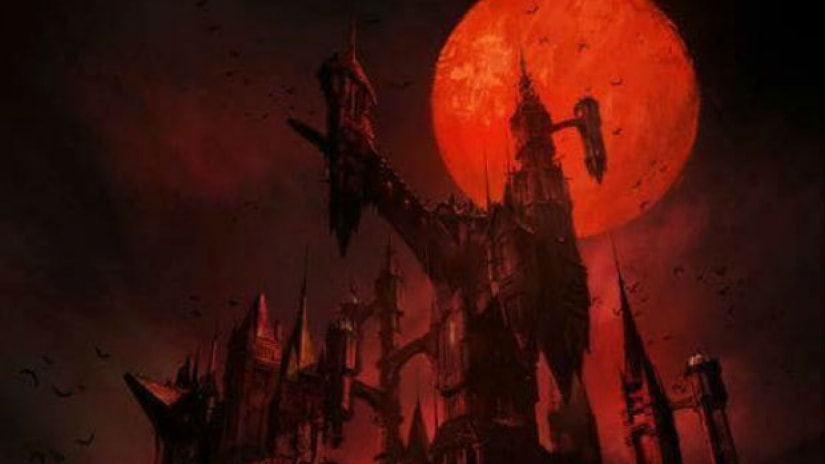
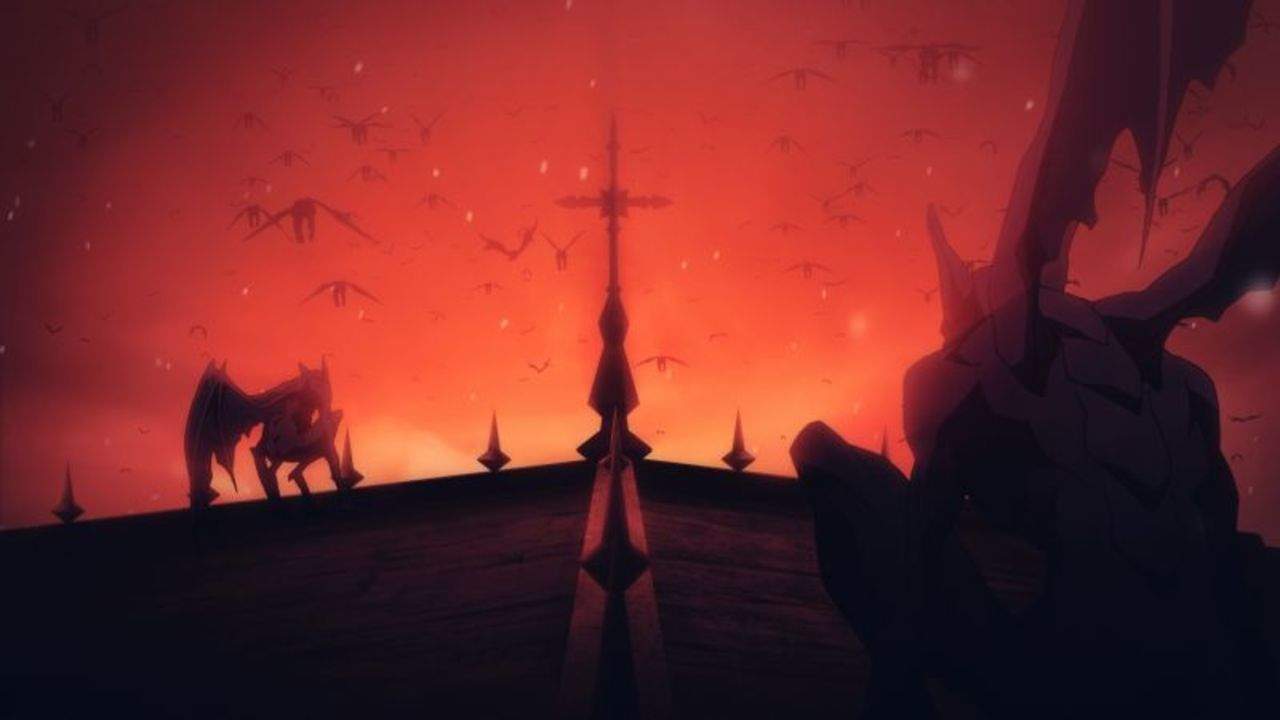
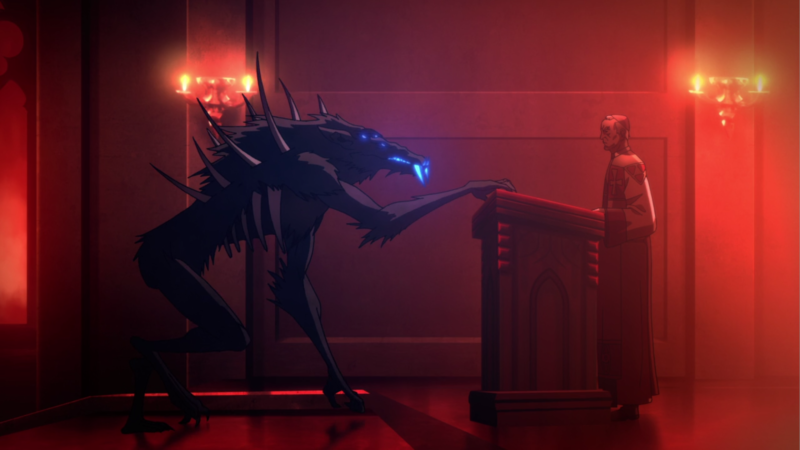
 RSS Feed
RSS Feed